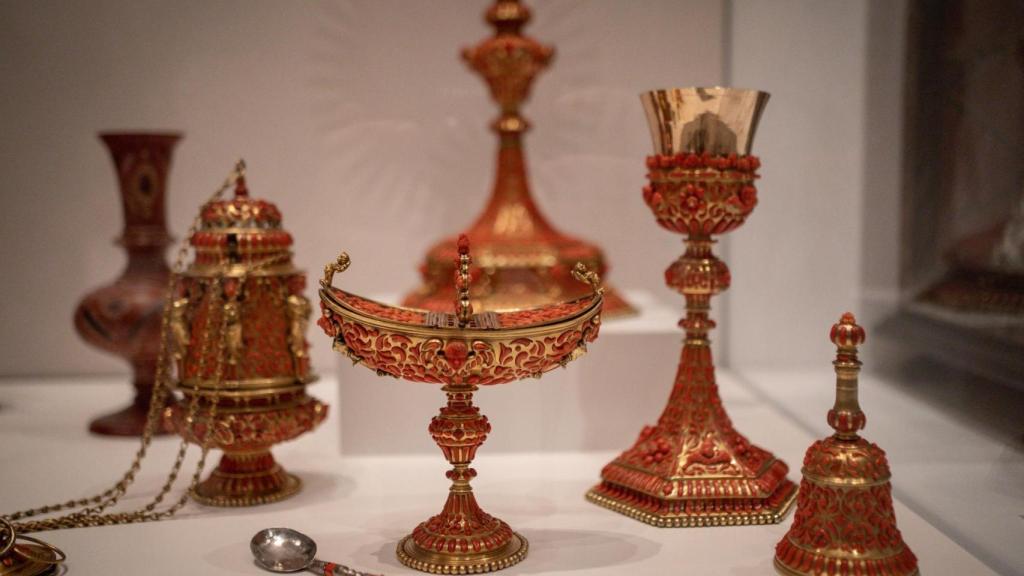At 9:45 am on Sunday, a few minutes after the museum opened, a group of unknown identity entered the Louvre’s Apollo Gallery through an area under construction next to the Seine. He entered through a lifting platform mounted on a truck in the construction zone and cut a window with power tools. In just 5 minutes he committed a historic robbery.
Even without the official inventory, it is estimated that they are nine jewels from the Napoleonic collection those that have disappeared: Among the stolen objects there would be a necklace, a brooch and a tiaraas well as other minor pieces linked to Napoleon and the Empress Eugenie.
The crown of the Spanish empress Eugenia (Eugénie de Montijo) appeared later damaged in the vicinity of the museum after the thieves fled, according to French media reports.
The blow replicates the logic of organized gangs who benefit from works and rehabilitations in the buildings, a circumstance that allows them easy access and a high speed of execution, with escape – usually – on a motorcycle. Paris has a streak of luxury assaults that demonstrate experience in this type of incident.
In the last five years have been made public at least 6 robberies in high jewelry stores such as Piaget, in 2023, with a loot of 10-15 million euros, Bulgari, in 2021, of approximately 10 million or at the prestigious Chaumet jewelry store, in 2021 with a theft of between 2 and 3 million, with a part of the valuable pieces recovered. Although the Louvre robbery is of incalculable value.
This museum was already questioned in terms of security due to the excessive flow of visitors, which on Sundays reaches its weekly peak of 30.000 personas, which hinders the surveillance and safety of the smallest pieces.
But can this happen in Spain?
Our great museums such as El Prado or the Royal Palace have the latest security technology, but Spain It has a lot of heritage that is not so well protected: see the theft of the Codex Calixtinus, or the theft of an original, leaving, in its place, a falsified copy of a work by Galileo in the National Library, of the Starry Messenger (1610).

View of one of the treasures displayed in the Gallery of the Royal Collections. Photo: Cristina Villarino
It is true that one A good part of the stolen jewelry is recovered. Operation Pandora led by the Spanish Civil Guard with the support of Europol and Interpol in 2024, resulted in 85 arrests and the recovery of more than 6,400 cultural assets.
Regarding this happening in Spain, Marta Pérez Ibañez, art historian, states: “The Louvre’s security measures were put in place as they are now in the 80s, and I know that Spanish museums have strict security measures. I think it would be very difficult to carry out a robbery like that.”
And he adds: “both Interpol and the CNI, like all national police forces, They are awaiting any work that appears in any market, both public and in auction houses and in a private market and can raise the alarm and thus recover the pieces.”
It is true that jewelry of such caliber would be practically impossible to sell on the secondary market where there is exhaustive monitoring and control of all the pieces that enter it. Faced with this possibility, Cipriano García, art historian, states: “When we are talking about jewelry, the only market that would be left would be dismantle the parts and sell them for partsdestroying the work and losing its value.”
The standards of ICOM (International Council of Museums) They are clear: the risk increases when there are rehabilitations and loading and unloading logistics; Prevention involves risk analysis, separate perimeters and timed drills.
Which pieces are most vulnerable?
Those who have small pieces of great value and easy access to the black market such as the Guarrazar Treasure (Visigoth crowns and pendants), distributed between the National Archaeological Museum (MAN), the Royal Palace of Madrid and the Musée de Cluny (Paris), the Aliseda Treasure (Phoenician-Tartesian, 7th century BC), and the Carambolo Treasure (protohistoric), preserved in the Archaeological Museum of Seville.
However the jewels of the Royal House (“passing jewels“, e.g. Fleur de Lis tiara), are private propertynot like the British “Crown Jewels”; and are not usually on public display.
Various information places its custody in the Royal Palace of Madridin high security facilities (vaulted chamber), from where They only go out for official events.
Although that location is not nominally confirmed for the passing jewelsyes it is for the crown and scepter (today exhibited in the Crown Room after decades in the vault), which proves the existence of that custody in the Palace itself.

